Multi-Scale Spatiotemporal Pattern Analysis and Simulation (MSPAS) Model with Driving Factors for Land Cover Change and Sustainable Development Goals: A Case Study of Nepal
Abstract
1. Introduction
2. Study Area and Materials
2.1. Study Area
2.2. Data
3. MSPAS Model with Driving Factors
3.1. Multi-Scale Analysis Criteria for the LCC Spatiotemporal Pattern
3.2. Driving Factors and Adaptive Land Suitability Evaluation
3.3. Simulation of LCC Using a CA-Markov Method
4. Results
4.1. Spatiotemporal Pattern of LCC at National Scale
4.2. Spatiotemporal Pattern of LCC at District Scale
4.2.1. Quantitative Transition Analysis
4.2.2. Spatial Transition Analysis
4.3. Multi-Scale Contribution and Correlation
4.4. LCC Simulation Result
5. Discussion
5.1. Performance and Theoretical Significance of the MSPAS Model
5.2. Application of the MSPAS Model for SDGs
5.2.1. The MSPAS Model for SDG 11 in Urban Expansion at the Expense of Farmland
5.2.2. The MSPAS Model for SDG 2 in Agriculture and Forestry
5.2.3. The MSPAS Model for Migration and Natural Disasters
6. Conclusions
Author Contributions
Funding
Data Availability Statement
Acknowledgments
Conflicts of Interest
References
- Chu, X.L.; Lu, Z.; Wei, D.; Lei, G.P. Effects of land use/cover change (LUCC) on the spatiotemporal variability of precipitation and temperature in the Songnen Plain, China. J. Integr. Agr. 2022, 21, 235–248. [Google Scholar] [CrossRef]
- Zhang, S.; Yang, P.; Xia, J.; Wang, W.; Cai, W.; Chen, N.; Hu, S.; Luo, X.; Li, J.; Zhan, C. Land use/land cover prediction and analysis of the middle reaches of the Yangtze River under different scenarios. Sci. Total Environ. 2022, 833, 155238. [Google Scholar] [CrossRef] [PubMed]
- Foley, J.A.; DeFries, R.; Asner, G.P.; Barford, C.; Bonan, G.; Carpenter, S.R.; Chapin, F.S.; Coe, M.T.; Daily, G.C.; Gibbs, H.K. Global consequences of land use. Science 2005, 309, 570–574. [Google Scholar] [CrossRef] [PubMed]
- Mustafa, A.; Szydłowski, M. The Impact of Spatiotemporal Changes in Land Development (1984–2019) on the Increase in the Runoff Coefficient in Erbil, Kurdistan Region of Iraq. Remote Sens. 2020, 12, 1302. [Google Scholar] [CrossRef]
- Zhou, Y.; Chen, M.; Tang, Z.; Mei, Z. Urbanization, land use change, and carbon emissions: Quantitative assessments for city-level carbon emissions in Beijing-Tianjin-Hebei region. Sustain. Cities Soc. 2021, 66, 102701. [Google Scholar] [CrossRef]
- Ding, Y.; Feng, H.; Zou, B.; Ye, S. Contribution Isolation of LUCC Impact on Regional PM2.5 Air Pollution: Implications for Sustainable Land and Environment Management. Front. Environ. Sci. 2022, 10, 825732. [Google Scholar] [CrossRef]
- Mararakanye, N.; Le Roux, J.J.; Franke, A.C. Long-term water quality assessments under changing land use in a large semi-arid catchment in South Africa. Sci. Total Environ. 2022, 818, 151670. [Google Scholar] [CrossRef]
- Ahmed, Z.; Asghar, M.M.; Malik, M.N.; Nawaz, K. Moving towards a sustainable environment: The dynamic linkage between natural resources, human capital, urbanization, economic growth, and ecological footprint in China. Resour. Policy 2020, 67, 101677. [Google Scholar] [CrossRef]
- Pma, B.; McDermid, S.S.; Qadir, A. A reporting framework for Sustainable Development Goal 15: Multi-scale monitoring of forest degradation using MODIS, Landsat and Sentinel data—ScienceDirect. Remote Sens. Environ. 2020, 237, 111592. [Google Scholar] [CrossRef]
- Khanal, U.; Wilson, C.; Rahman, S.; Lee, B.L.; Hoang, V. Smallholder farmers’ adaptation to climate change and its potential contribution to UN’s sustainable development goals of zero hunger and no poverty. J. Clean. Prod. 2021, 281, 124999. [Google Scholar] [CrossRef]
- Abubakar, I.R.; Aina, Y.A. The prospects and challenges of developing more inclusive, safe, resilient and sustainable cities in Nigeria. Land Use Policy 2019, 87, 104105. [Google Scholar] [CrossRef]
- Viana, C.M.; Freire, D.; Abrantes, P.; Rocha, J.; Pereira, P. Agricultural land systems importance for supporting food security and sustainable development goals: A systematic review. Sci. Total Environ. 2022, 806, 150718. [Google Scholar] [CrossRef] [PubMed]
- Liu, X.; Huang, Y.; Xu, X.; Li, X.; Li, X.; Ciais, P.; Lin, P.; Gong, K.; Ziegler, A.D.; Chen, A.; et al. High-spatiotemporal-resolution mapping of global urban change from 1985 to 2015. Nat. Sustain. 2020, 3, 564–570. [Google Scholar] [CrossRef]
- Zhang, D.; Pan, Y.; Zhang, J.; Hu, T.; Zhao, J.; Li, N.; Chen, Q. A generalized approach based on convolutional neural networks for large area cropland mapping at very high resolution. Remote Sens. Environ. 2020, 247, 111912. [Google Scholar] [CrossRef]
- Liu, H.; Gong, P.; Wang, J.; Wang, X.; Ning, G.; Xu, B. Production of global daily seamless data cubes and quantification of global land cover change from 1985 to 2020-iMap World 1.0. Remote Sens. Environ. 2021, 258, 112364. [Google Scholar] [CrossRef]
- Van den Hoek, J.; Smith, A.C.; Hurni, K.; Saksena, S.; Fox, J. Shedding New Light on Mountainous Forest Growth: A Cross-Scale Evaluation of the Effects of Topographic Illumination Correction on 25 Years of Forest Cover Change across Nepal. Remote Sens. 2021, 13, 2131. [Google Scholar] [CrossRef]
- Bey, A.; Jetimane, J.; Lisboa, S.N.; Ribeiro, N.; Sitoe, A.; Meyfroidt, P. Mapping smallholder and large-scale cropland dynamics with a flexible classification system and pixel-based composites in an emerging frontier of Mozambique. Remote Sens. Environ. 2020, 239, 111611. [Google Scholar] [CrossRef]
- Matlhodi, B.; Kenabatho, P.K.; Parida, B.P.; Maphanyane, J.G. Analysis of the Future Land Use Land Cover Changes in the Gaborone Dam Catchment Using CA-Markov Model: Implications on Water Resources. Remote Sens. 2021, 13, 2427. [Google Scholar] [CrossRef]
- Huang, Z.; Li, X.; Du, H.; Mao, F.; Han, N.; Fan, W.; Xu, Y.; Luo, X. Simulating Future LUCC by Coupling Climate Change and Human Effects Based on Multi-Phase Remote Sensing Data. Remote Sens. 2022, 14, 1698. [Google Scholar] [CrossRef]
- Fernandez-Beltran, R.; Baidar, T.; Kang, J.; Pla, F. Rice-Yield Prediction with Multi-Temporal Sentinel-2 Data and 3D CNN: A Case Study in Nepal. Remote Sens. 2021, 13, 1391. [Google Scholar] [CrossRef]
- Calderon-Loor, M.; Hadjikakou, M.; Bryan, B.A. High-resolution wall-to-wall land-cover mapping and land change assessment for Australia from 1985 to 2015. Remote Sens. Environ. 2021, 252, 112148. [Google Scholar] [CrossRef]
- Rose, S.; Kraatz, S.; Kellndorfer, J.; Cosh, M.H.; Torbick, N.; Huang, X.; Siqueira, P. Evaluating NISAR’s cropland mapping algorithm over the conterminous United States using Sentinel-1 data. Remote Sens. Environ. 2021, 260, 112472. [Google Scholar] [CrossRef]
- Thiam, S.; Salas, E.A.L.; Houngue, N.R.; Almoradie, A.D.S.; Verleysdonk, S.; Adounkpe, J.G.; Komi, K. Modelling Land Use and Land Cover in the Transboundary Mono River Catchment of Togo and Benin Using Markov Chain and Stakeholder’s Perspectives. Sustainability 2022, 14, 4160. [Google Scholar] [CrossRef]
- Bogaert, P.; Lamarche, C.; Defourny, P. Hidden Markov Models for Annual Land Cover Mapping-Increasing Temporal Consistency and Completeness. IEEE Trans. Geosci. Remote Sens. 2022, 60, 1–14. [Google Scholar] [CrossRef]
- Marondedze, A.K.; Schuett, B. Predicting the Impact of Future Land Use and Climate Change on Potential Soil Erosion Risk in an Urban District of the Harare Metropolitan Province, Zimbabwe. Remote Sens. 2021, 13, 4360. [Google Scholar] [CrossRef]
- Liang, X.; Guan, Q.; Clarke, K.C.; Chen, G.; Guo, S.; Yao, Y. Mixed-cell cellular automata: A new approach for simulating the spatio-temporal dynamics of mixed land use structures. Landsc. Urban Plan 2021, 205, 103960. [Google Scholar] [CrossRef]
- Yi, Y.; Zhang, C.; Zhu, J.; Zhang, Y.; Sun, H.; Kang, H. Spatio-Temporal Evolution, Prediction and Optimization of LUCC Based on CA-Markov and InVEST Models: A Case Study of Mentougou District, Beijing. Int. J. Environ. Res. Public Health 2022, 19, 2432. [Google Scholar] [CrossRef]
- Eyelade, D.; Clarke, K.C.; Ijagbone, I. Impacts of spatiotemporal resolution and tiling on SLEUTH model calibration and forecasting for urban areas with unregulated growth patterns. Int. J. Geogr. Inf. Sci. 2022, 36, 1037–1058. [Google Scholar] [CrossRef]
- Wu, S.; Gao, X.; Lei, J.; Zhou, N.; Wang, Y. Spatial and Temporal Changes in the Normalized Difference Vegetation Index and Their Driving Factors in the Desert/Grassland Biome Transition Zone of the Sahel Region of Africa. Remote Sens. 2020, 12, 4119. [Google Scholar] [CrossRef]
- Qureshi, S.; Shorabeh, S.N.; Samany, N.N.; Minaei, F.; Homaee, M.; Nickravesh, F.; Firozjaei, M.K.; Arsanjani, J.J. A New Integrated Approach for Municipal Landfill Siting Based on Urban Physical Growth Prediction: A Case Study Mashhad Metropolis in Iran. Remote Sens. 2021, 13, 949. [Google Scholar] [CrossRef]
- Estoque, R.C. A Review of the Sustainability Concept and the State of SDG Monitoring Using Remote Sensing. Remote Sens. 2020, 12, 1770. [Google Scholar] [CrossRef]
- Cochran, F.; Daniel, J.; Jackson, L.; Neale, A. Earth observation-based ecosystem services indicators for national and subnational reporting of the sustainable development goals. Remote Sens. Environ. 2020, 244, 111796. [Google Scholar] [CrossRef] [PubMed]
- Rimal, B.; Sloan, S.; Keshtkar, H.; Sharma, R.; Rijal, S.; Shrestha, U.B. Patterns of Historical and Future Urban Expansion in Nepal. Remote Sens. 2020, 12, 628. [Google Scholar] [CrossRef]
- Rimal, B.; Keshtkar, H.; Stork, N.; Rijal, S. Forest Cover and Sustainable Development in the Lumbini Province, Nepal: Past, Present and Future. Remote Sens. 2021, 13, 4093. [Google Scholar] [CrossRef]
- Rimal, B.; Zhang, L.; Stork, N.; Sloan, S.; Rijal, S. Urban Expansion Occurred at the Expense of Agricultural Lands in the Tarai Region of Nepal from 1989 to 2016. Sustainability 2018, 10, 1341. [Google Scholar] [CrossRef]
- Chaudhary, S.; Wang, Y.; Dixit, A.M.; Khanal, N.R.; Xu, P.; Fu, B.; Yan, K.; Liu, Q.; Lu, Y.; Li, M. A Synopsis of Farmland Abandonment and Its Driving Factors in Nepal. Land 2020, 9, 84. [Google Scholar] [CrossRef]
- Ahmed, Z.; Zafar, M.W.; Ali, S.; Danish. Linking urbanization, human capital, and the ecological footprint in G7 countries: An empirical analysis. Sustain. Cities Soc. 2020, 55, 102064. [Google Scholar] [CrossRef]
- Zhang, S.; Shao, H.; Li, X.; Xian, W.; Shao, Q.; Yin, Z.; Lai, F.; Qi, J. Spatiotemporal Dynamics of Ecological Security Pattern of Urban Agglomerations in Yangtze River Delta Based on LUCC Simulation. Remote Sens. 2022, 14, 296. [Google Scholar] [CrossRef]
- Homer, C.; Dewitz, J.; Jin, S.; Xian, G.; Riitters, K. Conterminous United States land cover change patterns 2001–2016 from the 2016 National Land Cover Database. ISPRS J. Photogramm. Remote Sens. 2020, 162, 184–199. [Google Scholar] [CrossRef]
- Wu, R.; Li, Z.; Wang, S. The varying driving forces of urban land expansion in China: Insights from a spatial-temporal analysis. Sci. Total Environ. 2021, 766, 63–77. [Google Scholar] [CrossRef]
- Aguejdad, R. The Influence of the Calibration Interval on Simulating Non-Stationary Urban Growth Dynamic Using CA-Markov Model. Remote Sens. 2021, 13, 468. [Google Scholar] [CrossRef]
- Kolecka, N. Greening trends and their relationship with agricultural land abandonment across Poland. Remote Sens. Environ. 2021, 257, 112340. [Google Scholar] [CrossRef]
- Radwan, T.M.; Blackburn, G.A.; Whyatt, J.D.; Atkinson, P.M. Dramatic Loss of Agricultural Land Due to Urban Expansion Threatens Food Security in the Nile Delta, Egypt. Remote Sens. 2019, 11, 332. [Google Scholar] [CrossRef]
- Tang, J.; Di, L. Past and Future Trajectories of Farmland Loss Due to Rapid Urbanization Using Landsat Imagery and the Markov-CA Model: A Case Study of Delhi, India. Remote Sens. 2019, 11, 180. [Google Scholar] [CrossRef]
- Tariq, A.; Shu, H. CA-Markov Chain Analysis of Seasonal Land Surface Temperature and Land Use Land Cover Change Using Optical Multi-Temporal Satellite Data of Faisalabad, Pakistan. Remote Sens. 2020, 12, 3402. [Google Scholar] [CrossRef]
- Tobler, W.R. A Computer Movie Simulating Urban Growth in the Detroit Region. Econ. Geogr. 1970, 46, 234–240. [Google Scholar] [CrossRef]
- Zhou, L.; Dang, X.; Sun, Q.; Wang, S. Multi-scenario simulation of urban land change in Shanghai by random forest and CA-Markov model. Sustain. Cities Soc. 2020, 55, 102045. [Google Scholar] [CrossRef]
- Liang, X.; Guan, Q.; Clarke, K.C.; Liu, S.; Wang, B.; Yao, Y. Understanding the drivers of sustainable land expansion using a patch-generating land use simulation (PLUS) model: A case study in Wuhan, China. Comput. Environ. Urban Syst. 2021, 85, 101569. [Google Scholar] [CrossRef]
- Yin, H.; Brandao, A., Jr.; Buchner, J.; Helmers, D.; Iuliano, B.G.; Kimambo, N.E.; Lewinska, K.E.; Razenkova, E.; Rizayeva, A.; Rogova, N.; et al. Monitoring cropland abandonment with Landsat time series. Remote Sens. Environ. 2020, 246, 111873. [Google Scholar] [CrossRef]
- Wang, S.W.; Gebru, B.M.; Lamchin, M.; Kayastha, R.B.; Lee, W.K. Land Use and Land Cover Change Detection and Prediction in the Kathmandu District of Nepal Using Remote Sensing and GIS. Sustainability 2020, 12, 3925. [Google Scholar] [CrossRef]
- Paudel, B.; Wu, X.; Zhang, Y.; Rai, R.; Liu, L.; Zhang, B.; Khanal, N.R.; Koirala, H.L.; Nepal, P. Farmland abandonment and its determinants in the different ecological villages of the Koshi river basin, central Himalayas: Synergy of high-resolution remote sensing and social surveys. Environ. Res. 2020, 188, 109711. [Google Scholar] [CrossRef] [PubMed]
- GoN. Nepal’s Sustainable Development Goals Progress Assessment Report 2016–2019; Government of Nepal, National Planning Commission: Kathmandu, Nepal, 2020.
- MoUD. National Urban Development Strategy (NUDS) 2017; Government of Nepal, Ministry of Urban Development: Kathmandu, Nepal, 2017.
- Rijal, S.; Rimal, B.; Stork, N.; Sharma, H.P. Quantifying the drivers of urban expansion in Nepal. Environ. Monit. Assess. 2020, 192, 633. [Google Scholar] [CrossRef] [PubMed]
- Song, X.; Feng, Q.; Xia, F.; Li, X.; Scheffran, J. Impacts of changing urban land-use structure on sustainable city growth in China: A population-density dynamics perspective. Habitat Int. 2021, 107, 102296. [Google Scholar] [CrossRef]
- Rimal, B.; Zhang, L.; Fu, D.; Kunwar, R.; Zhai, Y. Monitoring urban growth and the Nepal earthquake 2015 for sustainability of Kathmandu Valley, Nepal. Land 2017, 6, 42. [Google Scholar] [CrossRef]
- Khanal, N.; Uddin, K.; Matin, M.A.; Tenneson, K. Automatic Detection of Spatiotemporal Urban Expansion Patterns by Fusing OSM and Landsat Data in Kathmandu. Remote Sens. 2019, 11, 2296. [Google Scholar] [CrossRef]
- Amatya, P.; Kirschbaum, D.; Stanley, T. Use of Very High-Resolution Optical Data for Landslide Mapping and Susceptibility Analysis along the Karnali Highway, Nepal. Remote Sens. 2019, 11, 2284. [Google Scholar] [CrossRef]
- Rimal, B.; Zhang, L.; Keshtkar, H.; Sun, X.; Rijal, S. Quantifying the Spatiotemporal Pattern of Urban Expansion and Hazard and Risk Area Identification in the Kaski District of Nepal. Land 2018, 7, 37. [Google Scholar] [CrossRef]
- GoN. The Food Security Atlas of Nepal; Government of Nepal: Kathmandu, Nepal, 2019.
- Bhattarai, K.; Yousef, M.; Greife, A.; Naraharisetti, S. Influence of Topography on Sustainable Land Management: An Analysis of Socioeconomic and Ecodemographic Conditions of Nepal. Agriculture 2020, 10, 224. [Google Scholar] [CrossRef]
- Paudel, B.; Zhang, Y.; Yan, J.; Rai, R.; Li, L. Farmers’ perceptions of agricultural land use changes in Nepal and their major drivers. J. Environ. Manag. 2019, 235, 432–441. [Google Scholar] [CrossRef]
- Bekaert, D.P.S.; Handwerger, A.L.; Agram, P.; Kirschbaum, D.B. InSAR-based detection method for mapping and monitoring slow-moving landslides in remote regions with steep and mountainous terrain: An application to Nepal. Remote Sens. Environ. 2020, 249, 111983. [Google Scholar] [CrossRef]
- Tripathi, S.; Subedi, R.; Adhikari, H. Forest Cover Change Pattern after the Intervention of Community Forestry Management System in the Mid-Hill of Nepal: A Case Study. Remote Sens. 2020, 12, 2756. [Google Scholar] [CrossRef]
- Dai, J.; Roberts, D.A.; Stow, D.A.; An, L.; Zhao, Q. Green Vegetation Cover Has Steadily Increased since Establishment of Community Forests in Western Chitwan, Nepal. Remote Sens. 2020, 12, 4071. [Google Scholar] [CrossRef]
- Nepal, P.; Khanal, N.R.; Zhang, Y.; Paudel, B.; Liu, L. Land use policies in Nepal: An overview. Land Degrad. Dev. 2020, 31, 2203–2212. [Google Scholar] [CrossRef]
- CBS. Population Monograph of Nepal: National Planning Commission Secretariat; Central Bureau of Statistics (CBS): Kathmandu, Nepal, 2014. [Google Scholar]
- MoUD. National Urban Development Strategy (NUDS) 2015; Government of Nepal, Ministry of Urban Development: Kathmandu, Nepal, 2015.
- Adriano, B.; Yokoya, N.; Xia, J.; Miura, H.; Liu, W.; Matsuoka, M.; Koshimura, S. Learning from multimodal and multitemporal earth observation data for building damage mapping. ISPRS J. Photogramm. Remote Sens. 2021, 175, 132–143. [Google Scholar] [CrossRef]
- Delalay, M.; Ziegler, A.D.; Shrestha, M.S.; Gopal, V. Methodology for future flood assessment in terms of economic damage: Development and application for a case study in Nepal. J. Flood Risk Manag. 2020, 13, e12623. [Google Scholar] [CrossRef]
- Ghorbanzadeh, O.; Blaschke, T.; Gholamnia, K.; Meena, S.R.; Tiede, D.; Aryal, J. Evaluation of Different Machine Learning Methods and Deep-Learning Convolutional Neural Networks for Landslide Detection. Remote Sens. 2019, 11, 196. [Google Scholar] [CrossRef]
- Chen, J.; Tang, H.; Ge, J.; Pan, Y. Rapid Assessment of Building Damage Using Multi-Source Data: A Case Study of April 2015 Nepal Earthquake. Remote Sens. 2022, 14, 1358. [Google Scholar] [CrossRef]
- Qiu, H.; Hu, B.; Zhang, Z. Impacts of land use change on ecosystem service value based on SDGs report--Taking Guangxi as an example. Ecol. Indic. 2021, 133, 108366. [Google Scholar] [CrossRef]
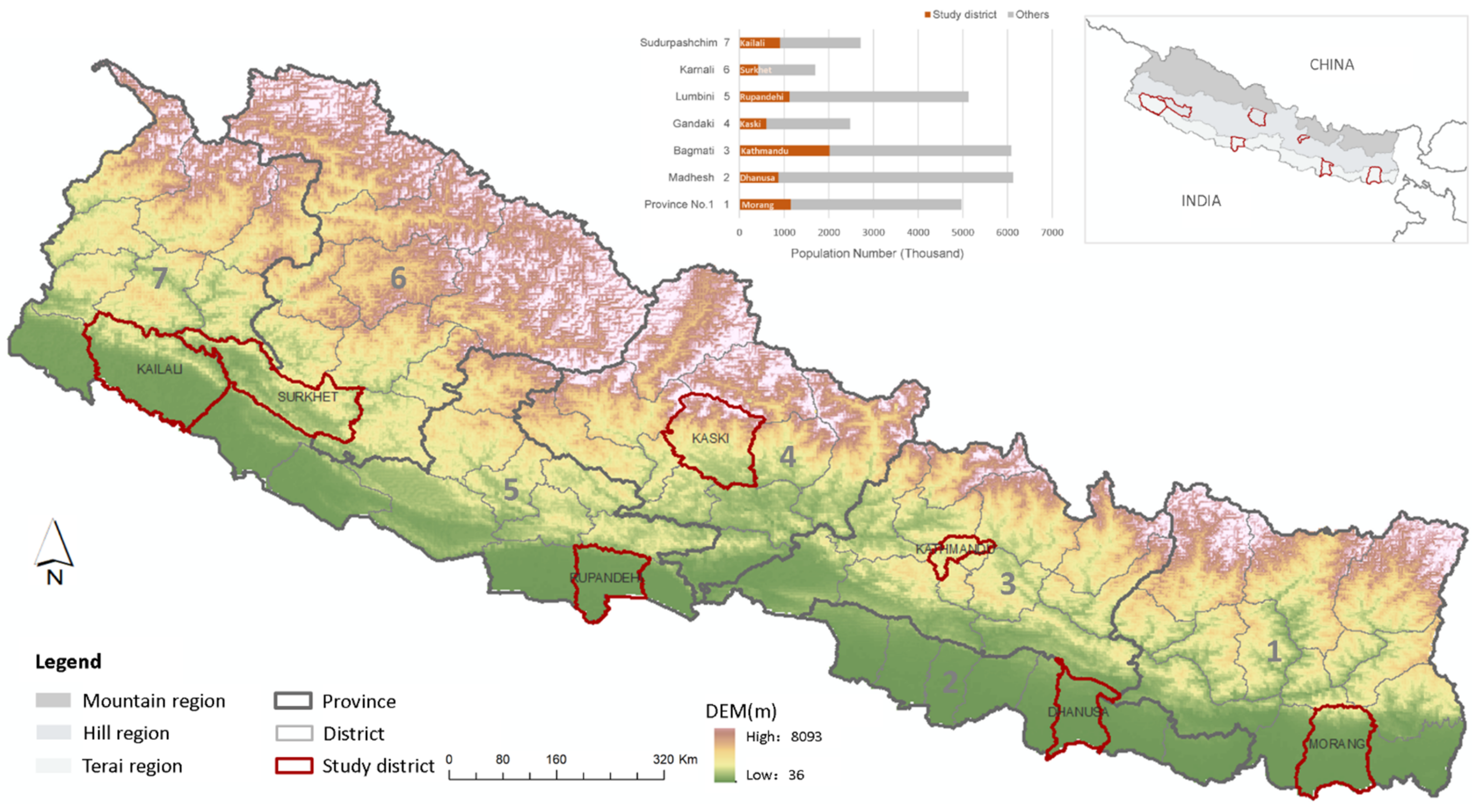
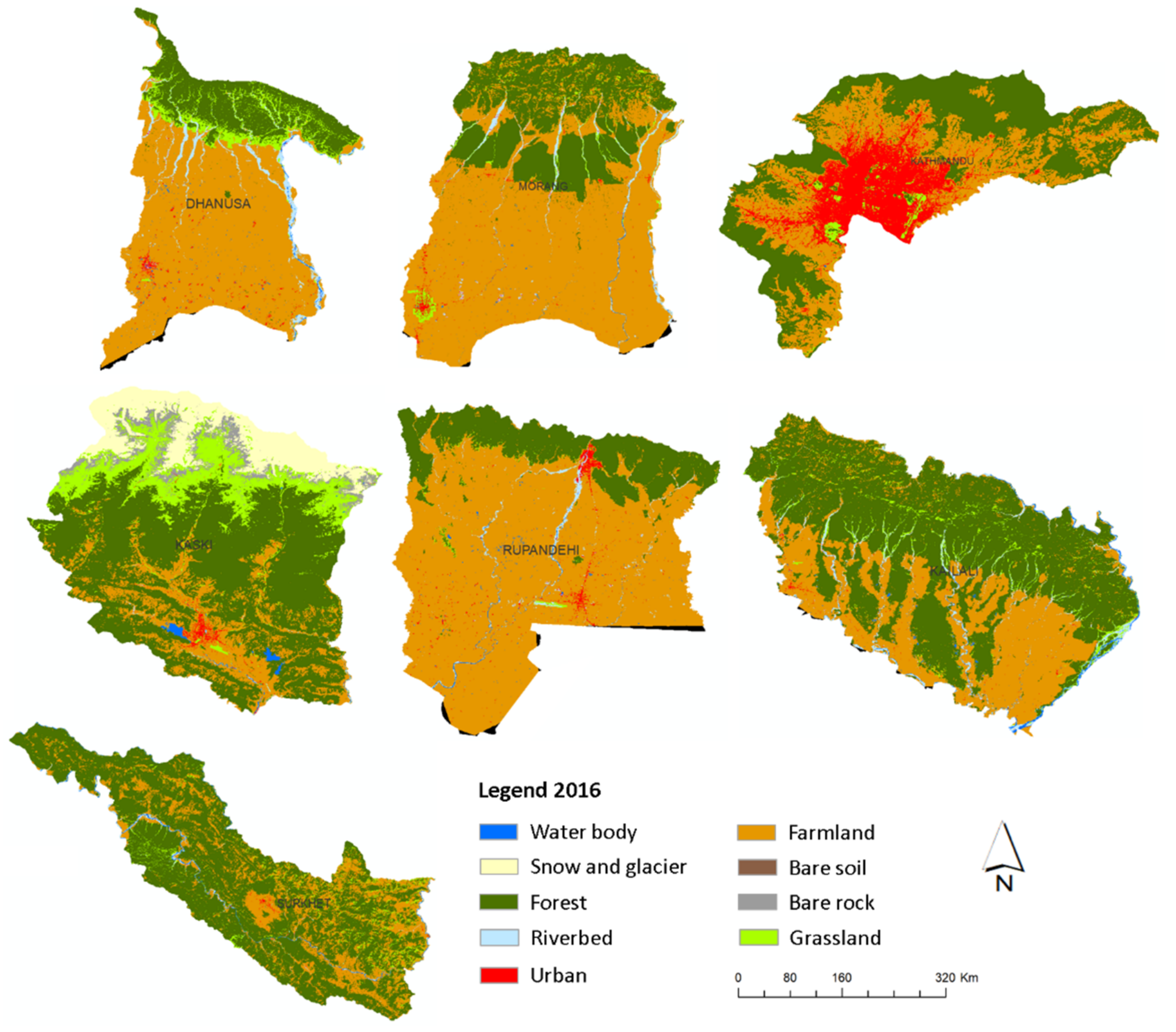

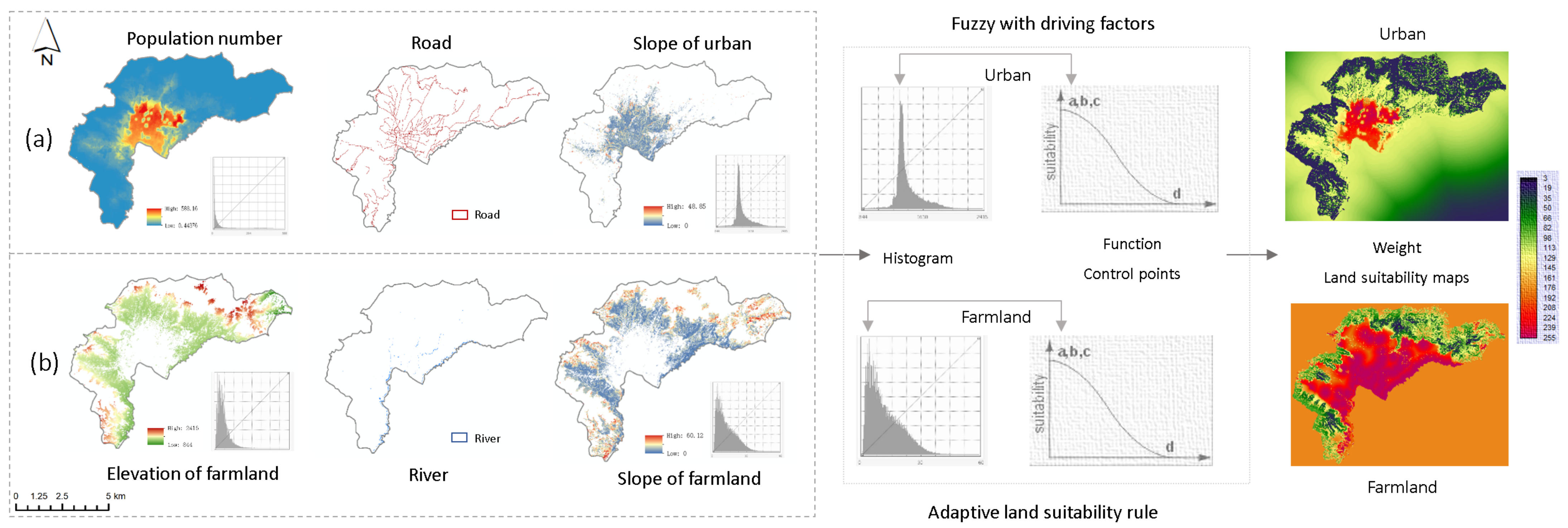
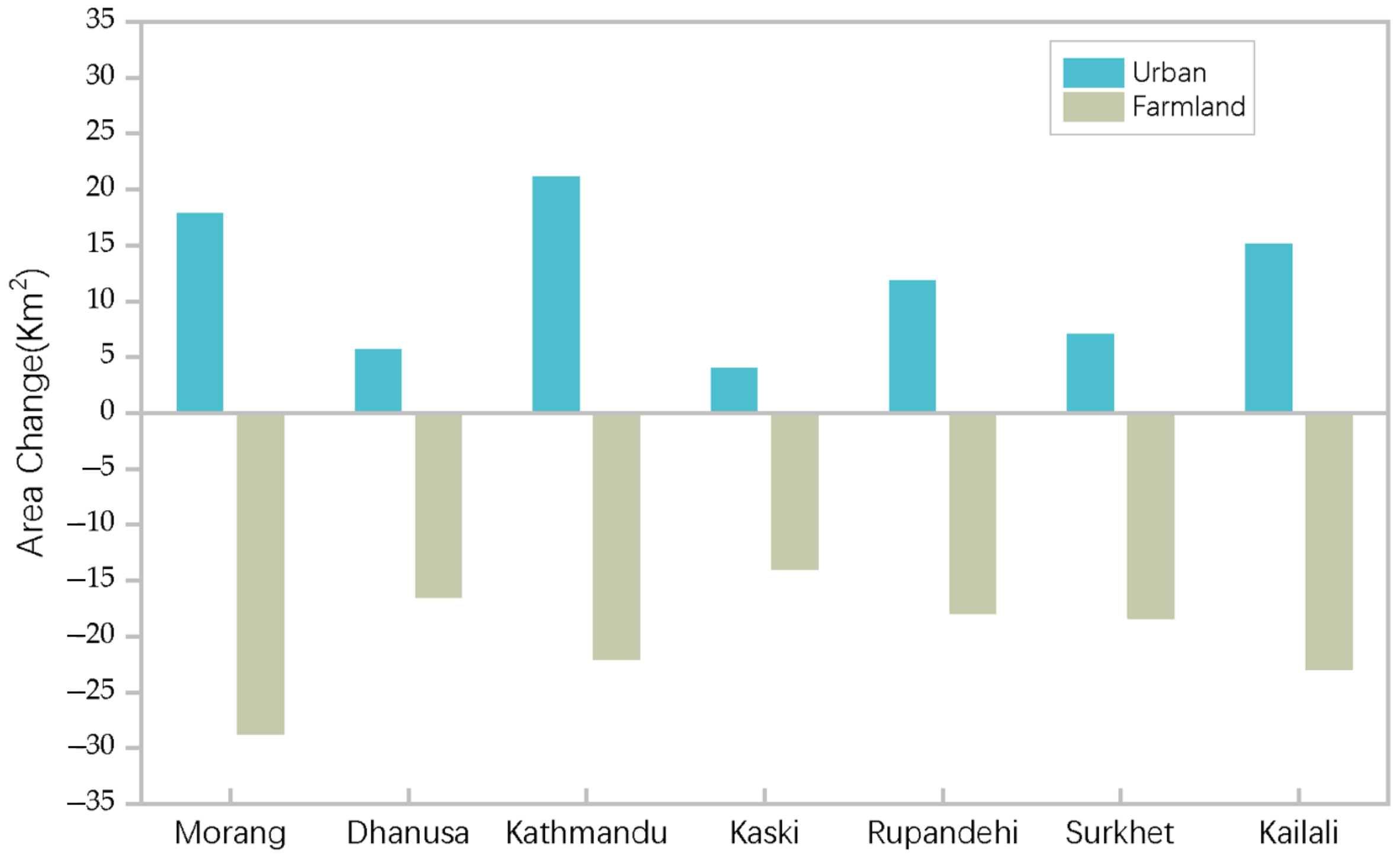
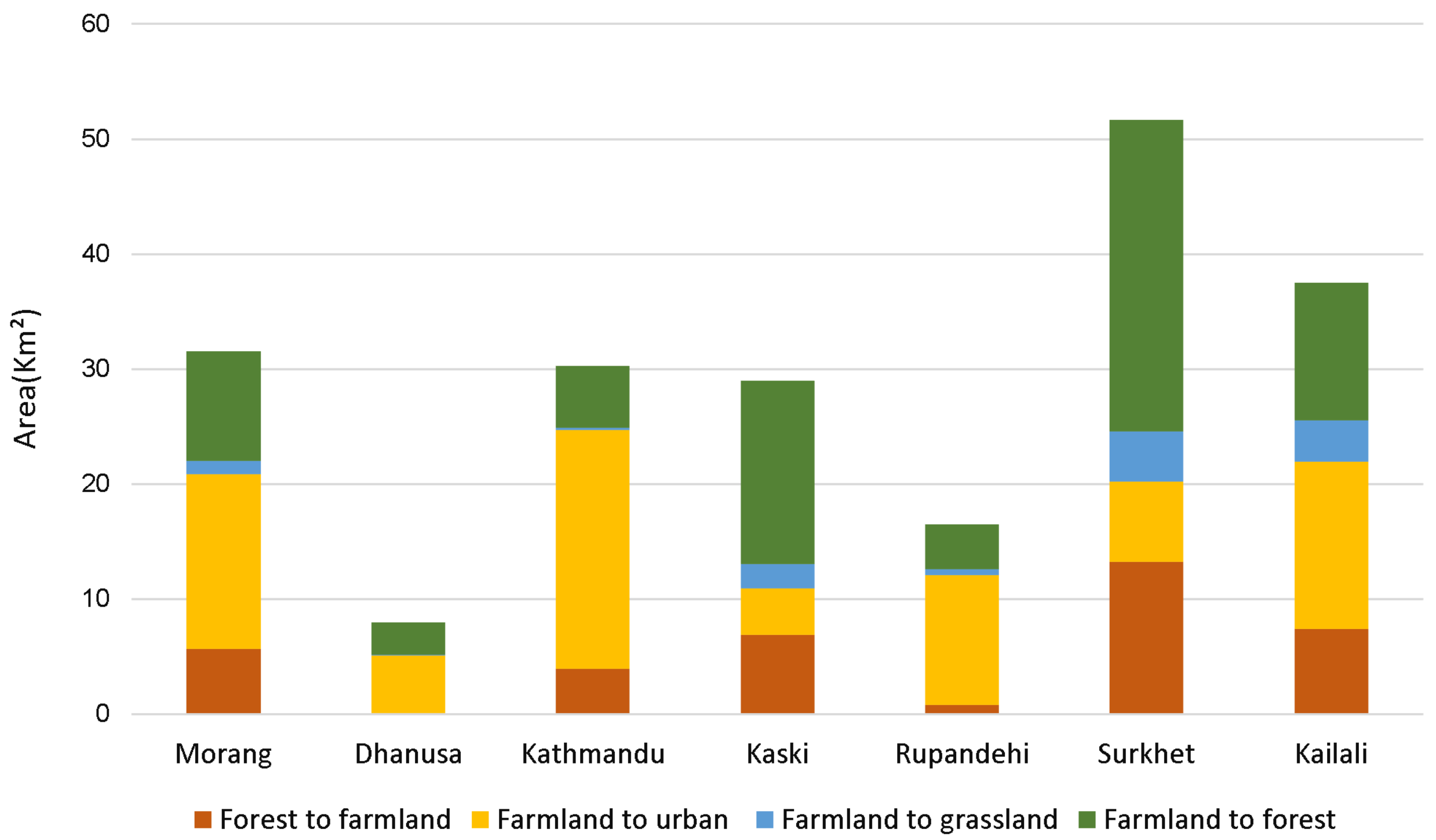
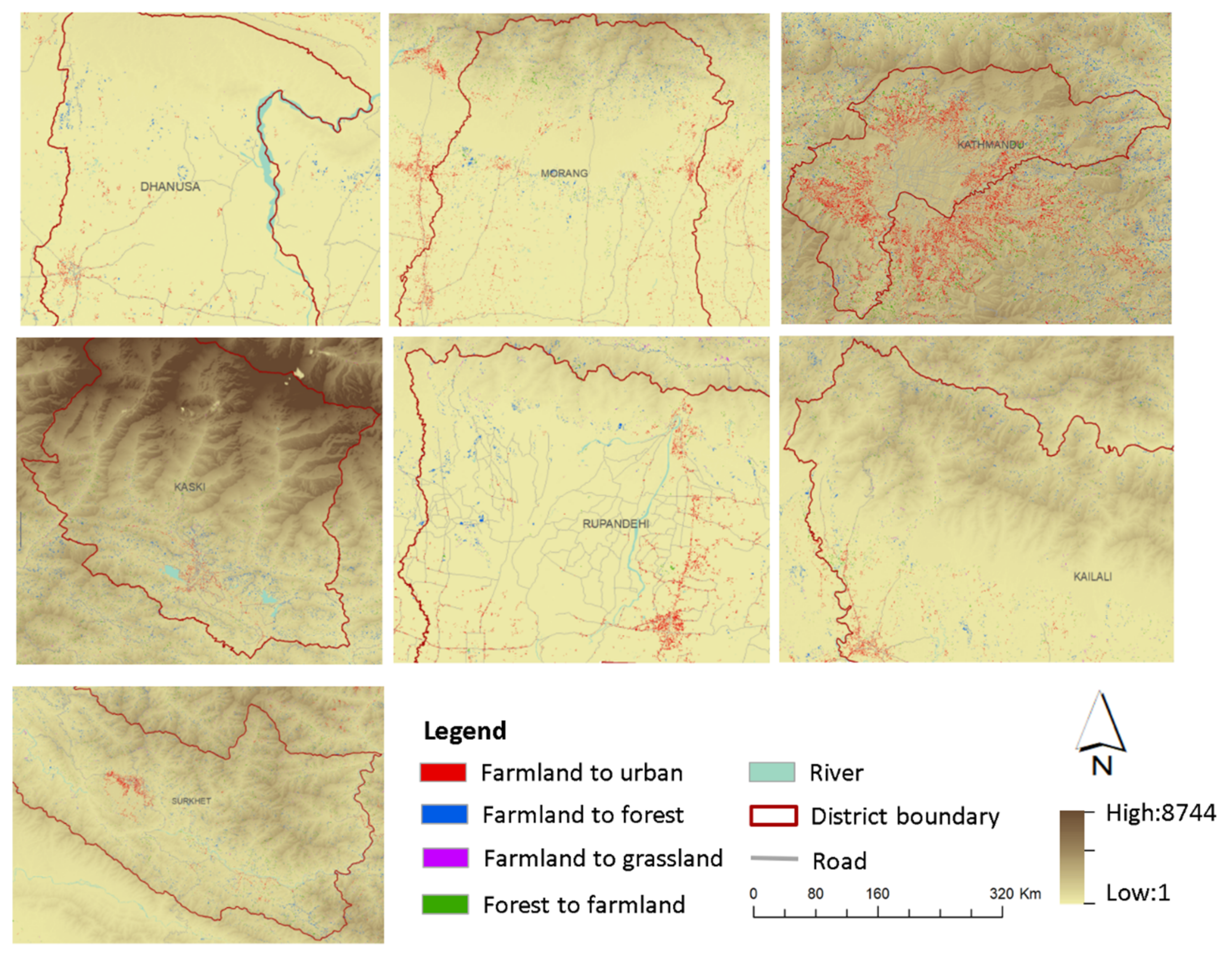
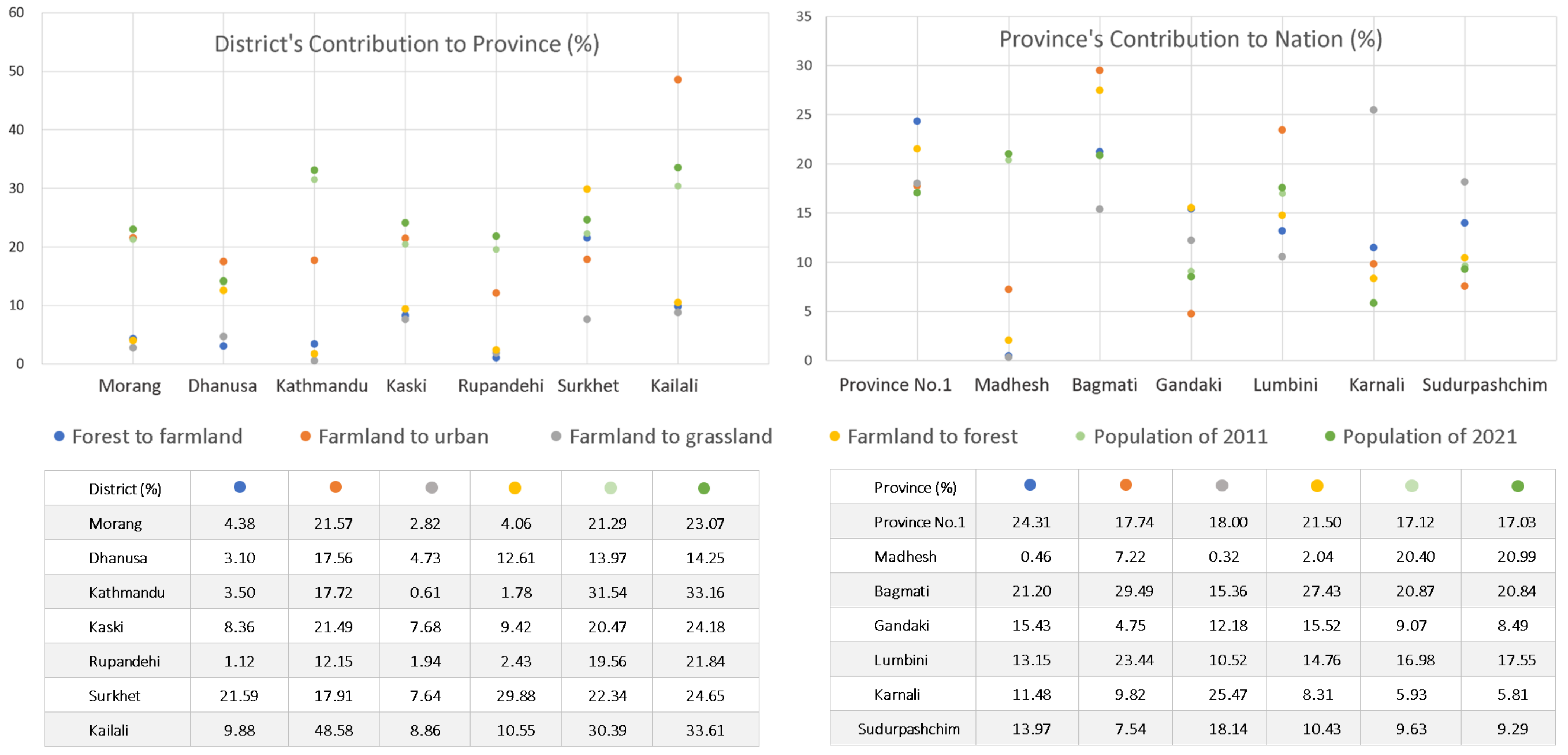
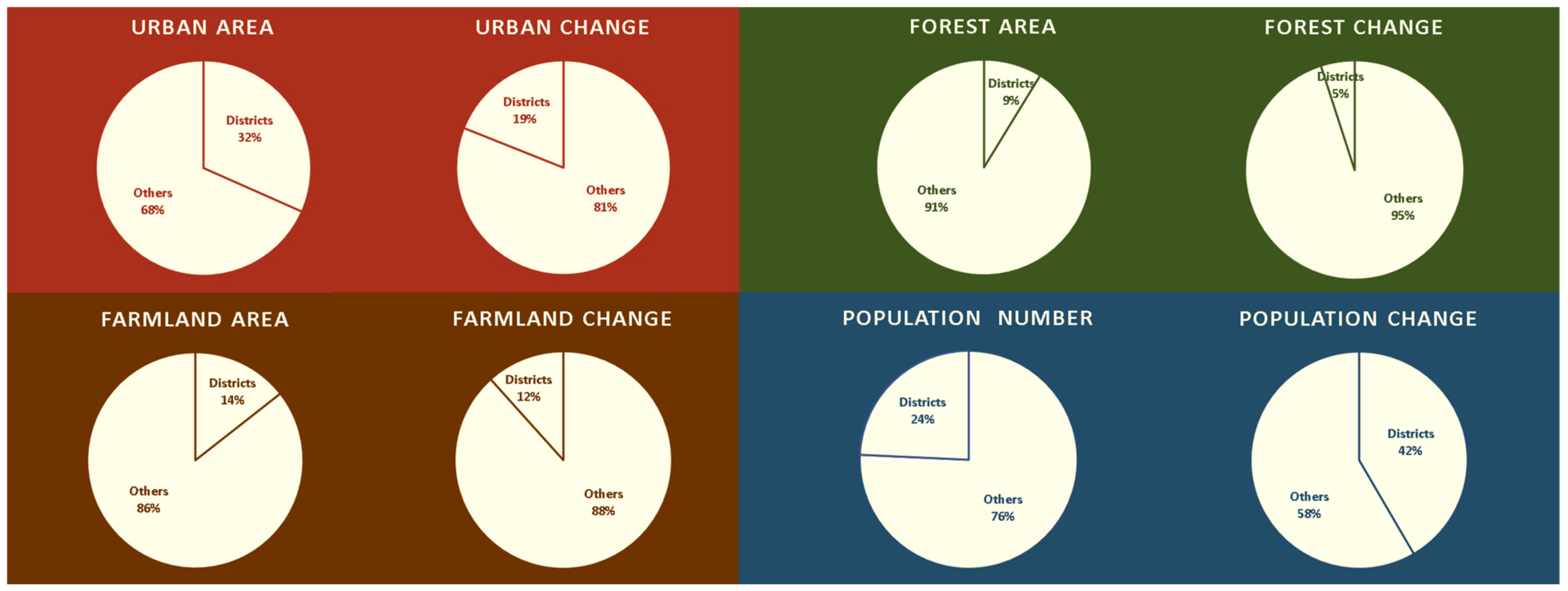
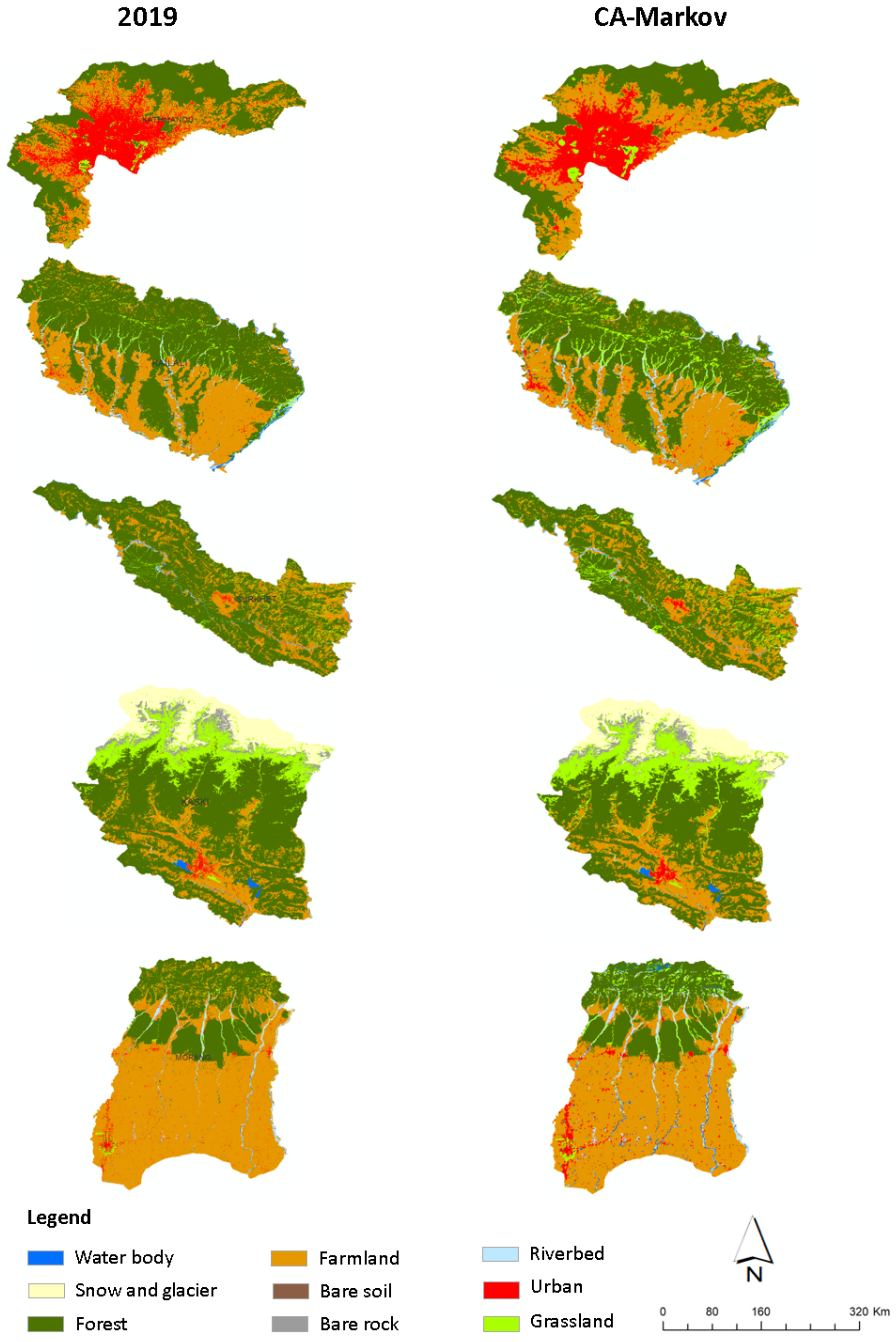
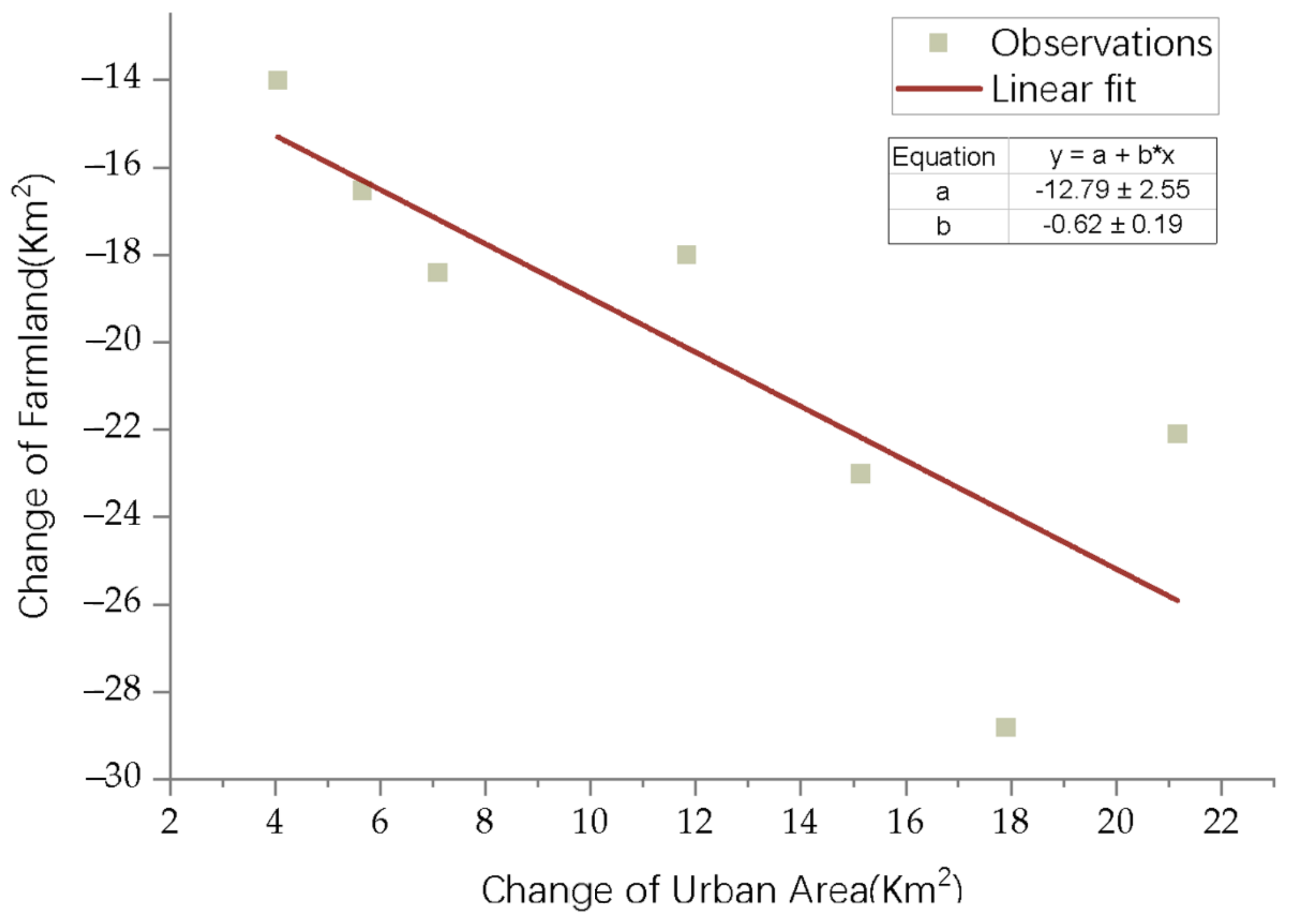
| Category | Data | Source | Property |
|---|---|---|---|
| Physical | Land cover maps | ICIMOD | Land cover classification |
| Topography | ASTER GDEMV2 | Elevation and slope | |
| River | OpenStreetMap | Accessibility to water resource | |
| Socio-economic | Road | OpenStreetMap | Accessibility to transport |
| Population distribution | WorldPop | Spatial distribution of population | |
| Population number | Central Bureau of Statistics (CBS), Government of Nepal | District, provincial and national population | |
| GDP | World Bank | Economy | |
| Political | Policy and planning | Government of Nepal | Political information about SDGs, agricultural and urban areas |
| 2017 | Forest | Urban | Farmland | Grassland | 2018 | Forest | Urban | Farmland | Grassland | ||
|---|---|---|---|---|---|---|---|---|---|---|---|
| 2016 | 2017 | ||||||||||
| Forest | 993.12 | 0.74 | 6.25 | 9.82 | Forest | 992.92 | 5.59 | 9.56 | 5.42 | ||
| Urban | 0.0001 | 990.88 | 0.02 | 0.03 | Urban | 0.0002 | 991.28 | 0.02 | 0.03 | ||
| Farmland | 7.08 | 144.85 | 980.69 | 3.30 | Farmland | 6.57 | 648.51 | 974.03 | 3.73 | ||
| Grassland | 3.19 | 15.32 | 1.51 | 890.22 | Grassland | 4.98 | 37.12 | 1.83 | 894.28 | ||
| 2019 | Forest | Urban | Farmland | Grassland | Dynamic degree of land covers (‰) | ||||||
| 2018 | |||||||||||
| Forest | 990.59 | 0.10 | 7.66 | 15.44 | Year | Forest | Urban | Farmland | Grassland | ||
| Urban | 0.0008 | 991.92 | 0.04 | 0.04 | 2016–17 | 3.46 | 166.35 | −10.71 | −7.95 | ||
| Farmland | 7.32 | 0.69 | 980.91 | 4.91 | 2017–18 | 4.68 | 710.55 | −13.74 | −4.06 | ||
| Grassland | 1.77 | 1.24 | 1.90 | 840.16 | 2018–19 | −0.23 | −3.31 | −8.76 | −78.05 | ||
| Correlation in DP and PN | Forest to Farmland | Farmland to Urban | Farmland to Grassland | Farmland to Forest | ||||
|---|---|---|---|---|---|---|---|---|
| DP | PN | DP | PN | DP | PN | DP | PN | |
| Forest to farmland | 1.00 | 1.00 | ||||||
| Farmland to urban | 0.21 | 0.53 | 1.00 | 1.00 | ||||
| Farmland to grassland | 0.70 | 0.58 | 0.61 | 0.08 | 1.00 | 1.00 | ||
| Farmland to forest | 0.91 | 0.91 | 0.05 | 0.75 | 0.66 | 0.32 | 1.00 | 1.00 |
| 2011 Population | 0.15 | 0.02 | 0.54 | 0.62 | −0.01 | −0.63 | −0.18 | 0.31 |
| 2021 Population | 0.20 | −0.02 | 0.57 | 0.62 | 0.09 | −0.65 | −0.16 | 0.28 |
| Contribution RN (%) | Forest to Farmland | Farmland to Urban | Farmland to Grassland | Farmland to Forest |
|---|---|---|---|---|
| Terai | 12 | 50 | 7 | 13 |
| Hill | 80 | 45 | 74 | 76 |
| Mountain | 8 | 5 | 19 | 11 |
| Correlation in RN | Forest to farmland | Farmland to urban | Farmland to grassland | Farmland to forest |
| Forest to farmland | 1.00 | |||
| Farmland to urban | 0.45 | 1.00 | ||
| Farmland to grassland | 0.98 | 0.25 | 1.00 | |
| Farmland to forest | 1.00 | 0.43 | 0.98 | 1.00 |
| 2011 population | 0.40 | 1.00 | 0.20 | 0.38 |
| 2021 population | 0.29 | 0.98 | 0.08 | 0.27 |
| Morang | Forest | Urban | Farmland | Grassland | Dhanusa | Forest | Urban | Farmland | Grassland |
| Forest | 83.54 | 0.06 | 11.19 | 4.94 | Forest | 83.81 | 0.00 | 0.53 | 15.57 |
| Urban | 0.10 | 84.03 | 5.07 | 7.27 | Urban | 0.01 | 84.00 | 11.41 | 0.01 |
| Farmland | 6.00 | 3.33 | 83.58 | 0.87 | Farmland | 1.87 | 2.59 | 83.56 | 0.08 |
| Grassland | 8.70 | 6.89 | 3.20 | 73.47 | Grassland | 18.48 | 0.03 | 0.16 | 79.46 |
| Kathmandu | Forest | Urban | Farmland | Grassland | Rupandehi | Forest | Urban | Farmland | Grassland |
| Forest | 82.94 | 0.58 | 14.63 | 1.85 | Forest | 84.51 | 0.04 | 7.36 | 7.04 |
| Urban | 0.98 | 84.73 | 10.13 | 3.77 | Urban | 0.01 | 84.23 | 10.21 | 0.01 |
| Farmland | 7.38 | 16.26 | 76.16 | 0.19 | Farmland | 4.54 | 5.31 | 83.81 | 0.42 |
| Grassland | 6.66 | 17.01 | 2.23 | 74.09 | Grassland | 34.04 | 0.57 | 7.03 | 56.06 |
| Kaski | Forest | Urban | Farmland | Grassland | Surkhet | Forest | Urban | Farmland | Grassland |
| Forest | 84.00 | 0.01 | 8.60 | 6.96 | Forest | 84.10 | 0.02 | 9.77 | 5.97 |
| Urban | 0.11 | 82.57 | 8.50 | 0.62 | Urban | 0.09 | 84.59 | 4.64 | 3.03 |
| Farmland | 16.25 | 2.04 | 79.88 | 1.31 | Farmland | 14.07 | 1.85 | 81.50 | 2.11 |
| Grassland | 2.08 | 0.12 | 0.59 | 70.06 | Grassland | 14.19 | 0.02 | 9.32 | 75.42 |
| Kailali | Forest | Urban | Farmland | Grassland | |||||
| Forest | 84.36 | 0.01 | 7.08 | 6.91 | |||||
| Urban | 0.04 | 84.60 | 6.45 | 0.94 | |||||
| Farmland | 6.85 | 3.02 | 83.18 | 1.50 | |||||
| Grassland | 15.73 | 0.06 | 3.77 | 76.32 |
| Districts (%) | PA | UA | Districts | PA | UA |
|---|---|---|---|---|---|
| Morang | 87.91 | 97.50 | Dhanusa | 85.19 | 99.44 |
| Kathmandu | 86.82 | 78.63 | Rupandehi | 86.71 | 99.44 |
| Kaski | 89.44 | 78.57 | Surkhet | 89.60 | 79.56 |
| Kailali | 90.64 | 91.95 |
| Study District | Population | Growth in 10 Years | Province | GDP of Agriculture and Forestry (%) | ||
|---|---|---|---|---|---|---|
| 2011 | 2021 | Nation | Province | |||
| Morang | 965,370 | 1,147,186 | 181,816 | Province No.1 | 21.53 | 36.37 |
| Dhanusa | 754,777 | 873,274 | 118,497 | Madhesh | 19.00 | 37.90 |
| Kathmandu | 1,744,240 | 2,017,532 | 273,292 | Bagmati | 17.09 | 12.96 |
| Kaski | 492,098 | 599,504 | 107,406 | Gandaki | 9.95 | 29.91 |
| Rupandehi | 880,196 | 1,118,975 | 238,779 | Lumbini | 17.31 | 30.18 |
| Surkhet | 350,804 | 417,776 | 66,972 | Karnali | 5.39 | 32.85 |
| Kailali | 775,709 | 911,155 | 135,446 | Sudurpashchim | 9.73 | 37.98 |
Publisher’s Note: MDPI stays neutral with regard to jurisdictional claims in published maps and institutional affiliations. |
© 2022 by the authors. Licensee MDPI, Basel, Switzerland. This article is an open access article distributed under the terms and conditions of the Creative Commons Attribution (CC BY) license (https://creativecommons.org/licenses/by/4.0/).
Share and Cite
Jia, W.; Gu, X.; Mi, X.; Yang, J.; Zang, W.; Liu, P.; Yan, J.; Zhu, H.; Zhang, X.; Zhang, Z. Multi-Scale Spatiotemporal Pattern Analysis and Simulation (MSPAS) Model with Driving Factors for Land Cover Change and Sustainable Development Goals: A Case Study of Nepal. Remote Sens. 2022, 14, 6295. https://doi.org/10.3390/rs14246295
Jia W, Gu X, Mi X, Yang J, Zang W, Liu P, Yan J, Zhu H, Zhang X, Zhang Z. Multi-Scale Spatiotemporal Pattern Analysis and Simulation (MSPAS) Model with Driving Factors for Land Cover Change and Sustainable Development Goals: A Case Study of Nepal. Remote Sensing. 2022; 14(24):6295. https://doi.org/10.3390/rs14246295
Chicago/Turabian StyleJia, Wenqi, Xingfa Gu, Xiaofei Mi, Jian Yang, Wenqian Zang, Peizhuo Liu, Jian Yan, Hongbo Zhu, Xuming Zhang, and Zhouwei Zhang. 2022. "Multi-Scale Spatiotemporal Pattern Analysis and Simulation (MSPAS) Model with Driving Factors for Land Cover Change and Sustainable Development Goals: A Case Study of Nepal" Remote Sensing 14, no. 24: 6295. https://doi.org/10.3390/rs14246295
APA StyleJia, W., Gu, X., Mi, X., Yang, J., Zang, W., Liu, P., Yan, J., Zhu, H., Zhang, X., & Zhang, Z. (2022). Multi-Scale Spatiotemporal Pattern Analysis and Simulation (MSPAS) Model with Driving Factors for Land Cover Change and Sustainable Development Goals: A Case Study of Nepal. Remote Sensing, 14(24), 6295. https://doi.org/10.3390/rs14246295







